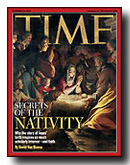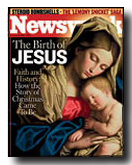Cover Story
- GEORGE SIM JOHNSTON
Time and Newsweek put the Gospels to the test.
 |  |
Since the late 18th century, there has been a scholarly assault on the four Gospels, and some of the "experts" quoted by Time and Newsweek are simply bringing up the rear of this cultural offensive. Enlightenment intellectuals like Voltaire and Diderot could not accept Christ as a divine person. But since he is clearly presented as such in the Gospels, the idea was to deconstruct the texts themselves. Scholars accordingly came up with a storyline that goes something like this:
There was this charismatic religious teacher an itinerant rabbi, a political revolutionary who wandered about first-century Palestine saying some wonderful things but who certainly was not God. After he died, his followers took the sayings of Jesus and put them in a book. Later, the so-called Gospel writers took this document (which we don't have) and added a lot of mythological material about miracles and claims of Christ's divinity. The role of the scholar, then, is to strip away these mythological elements to get to the "historical Jesus" who ends up bearing a curious resemblance to the scholar writing the book.
Needless to say, these critics pare down the Nativity story until there is nothing left. If you read the Gospels with the assumption that miracles do not happen, then the Annunciation, the Virgin Birth and the angels' appearance to the shepherds will end up on the cutting-room floor. While they're at it, these scholars question some purely historical details, such as the place of Jesus' birth. Time claims that a "majority" of scholars now favor Nazareth as the scene of the Nativity.
But these scholars don't even bother to look at certain ancient sources. In the early third century, for example, Origen, one of the most brilliant men of his age, could write: "In Bethlehem you are shown the cave where he was born. . . . These things which they show you are recognized in the district." This is not perhaps clinching evidence; but people back then did have long memories, so why not accept this as corroboration of what the Gospel writers calmly report to be true?
Mark and John give no details of Jesus' birth, so that leaves Matthew and Luke. While the ancient Roman historian Livy makes it clear that he does not take the story of Romulus and Remus seriously, Matthew and Luke are writing of events, angels and all, with the conviction of truth. Luke in particular gives the impression of being a meticulous fact-gatherer. So where did he get the details of the Annunciation? Twice he says that Mary "kept in mind all these things, pondering them in her heart." An indication, perhaps, of his best source. Some early Church Fathers write that Mary outlived her son by many years.
In the end, it is more profitable to contemplate the Gospels than to make them the sport of learned suspicions. We find around the crèche (a Christmas devotion more or less invented by St. Francis) the shepherds and the Magi of the Gospels. These were real people, which does not preclude their representing something much larger than themselves.
From plastic tableaux under Christmas trees, we tend to have an idealized image of those shepherds. But one historian writes: "To the right-minded in high places, mountain shepherds were the very scum of Israel, men of violence, thieves, perjurers, scorners of the Law." As would be the case with Mary Magdalene, Christ is reaching out especially to people whom everyone else has written off.
As for the Magi, who arrive on the scene a few days late: I rather like the prayer that Evelyn Waugh writes about them for the heroine of his novel "Helena": "You are my especial patrons," she says, ". . . and patrons of all late-comers, of all who have a tedious journey to make to the truth, of all who are confused with knowledge and speculation. . . . For his sake who did not reject your curious gifts, pray always for all the learned, the oblique, the delicate. Let them not be quite forgotten at the Throne of God when the simple come into their kingdom."
May we not include among the learned and oblique a few biblical scholars?
 This is Meaghen Gonzalez, Editor of CERC. I hope you appreciated this piece. We curate these articles especially for believers like you.
This is Meaghen Gonzalez, Editor of CERC. I hope you appreciated this piece. We curate these articles especially for believers like you.
Please show your appreciation by making a $3 donation. CERC is entirely reader supported.

Acknowledgement
George Sim Johnston. "Cover Story." reprint The Wall Street Journal (December 10, 2004).
This article reprinted with permission ofThe Wall Street Journal © 2004 Dow Jones & Company, Inc. All rights reserved.
The Author
 George Sim Johnston is a writer living in New York City. He graduated from Harvard with a B. A. in English literature and was an investment banker with Salomon Brothers in the seventies and early eighties. Since then he has been a free-lance writer, publishing with The Wall Street Journal, Harper's, Commentary, Harvard Business Review, National Catholic Register, World Catholic Report, and other publications. He is a three-time winner of the Journalism Award from the Catholic Press Association. He teaches marriage preparation and CCD for the Archdiocese of New York and is the author of Did Darwin Get it Right?: Catholics and the Theory of Evolution.
George Sim Johnston is a writer living in New York City. He graduated from Harvard with a B. A. in English literature and was an investment banker with Salomon Brothers in the seventies and early eighties. Since then he has been a free-lance writer, publishing with The Wall Street Journal, Harper's, Commentary, Harvard Business Review, National Catholic Register, World Catholic Report, and other publications. He is a three-time winner of the Journalism Award from the Catholic Press Association. He teaches marriage preparation and CCD for the Archdiocese of New York and is the author of Did Darwin Get it Right?: Catholics and the Theory of Evolution.




